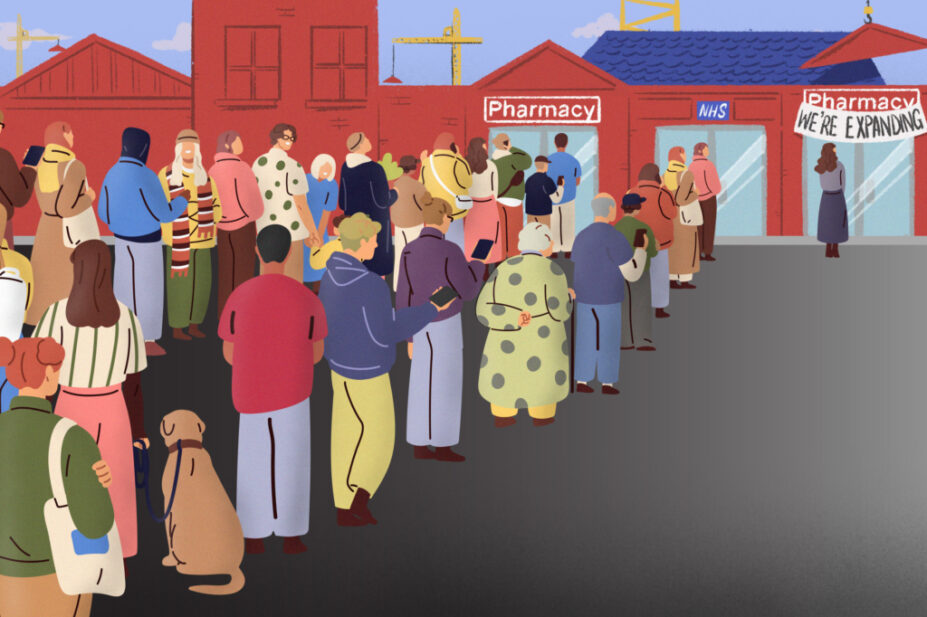
Shutterstock.com / The Pharmaceutical Journal
When the government announced in May 2023 that it had met its target to recruit 26,000 additional staff into primary care a year early, the reaction from pharmacy bodies was swift — and largely negative[1].
Malcolm Harrison, chief executive of the Company Chemists’ Association (CCA), said recruitment of pharmacists under the Additional Roles Reimbursement Scheme (ARRS) by primary care networks (PCNs) should “immediately halt”, while Nick Kaye, chair of the National Pharmacy Association, said PCNs’ recruitment of pharmacists has “stripped away staff from [community] pharmacy”[2]. Janet Morrison, chief executive of Community Pharmacy England (CPE), described the process as “poaching community pharmacy staff”, adding that it was “very damaging and ill considered”[3].
Community pharmacy is undoubtedly under pressure. CPE describes a 30% reduction in remuneration over the past seven years, with funding cuts being the biggest threat to business[4]. Some 670 pharmacies closed between 2015 and 2022, and the CCA warned that a further 50 would close in 2022/2023[5,6]. The annual RPS pharmacist wellbeing survey found that 70% of pharmacists cited inadequate staffing as a leading source of stress, while 53% reported a lack of work-life balance and 48% said they lacked protected learning time[7].
Pharmacy professionals are an asset to patients in general practice
But general practice is also facing higher demand than ever. Between 2015 and 2023, the number of GP practices in England reduced by 1,231 and GP workforce data show a loss of 471 full-time equivalent GPs in the year to November 2022, which the British Medical Association says “speaks volumes to the intense pressures that practices and staff are under”[8,9].
Prematurely halting PCN recruitment, as advocated by these pharmacy bodies, before the end of the five-year framework for the GP contract would have a very serious impact on funding for PCNs and practices beyond April 2024[10].
Pharmacy professionals are an asset to patients in general practice and many PCN clinical directors will wish to maximise recruitment within their agreed funding allocations in 2023 to avoid this money being lost, along with the expertise, safety and capacity of the workforce it would have funded[11].
In community pharmacy bodies’ reactions against the ARRS, they forget that the recruitment of pharmacists into general practice using incentives and centralised funding from NHS England is not new. It first started back in July 2015, with the ‘Clinical Pharmacists in General Practice Pilot’[12]. The initial plans were to recruit 40 senior pharmacists and 200 pharmacists to work in general practice and required federations or groups of practices to bid for funding.
I led one such successful bid; by April 2017, we had successfully recruited 8 pharmacists to work in 17 practices in Ealing, West London. Former health minister David Mowatt visited us at the time and sat with one of our senior pharmacists, Yaksheeta Dave, as she consulted with a patient with diabetes[13]. Yaksheeta is now clinical director of her PCN.
At the time, the government had committed to hire 1,500 pharmacists in general practice by 2020. This was superseded in 2019 by the ARRS and new government plans to recruit up to 7,500 by 2023/2024[14]. Funding for the salary of those posts encouraged PCNs to accelerate recruitment of pharmacists to work in practices in patient-facing roles, providing prescribing, advanced examination techniques and history taking, and delivering structured medication reviews.
The most recent data show that the number of pharmacists recruited to primary care networks is still smaller than the increase in the number of pharmacists working in the community
But despite the additional funding, the most recent data show that the number of pharmacists recruited to PCNs is still smaller than the increase in the number of pharmacists working in the community.
Official data from NHS England reveal a total of 8,576 pharmacy professionals now working in general practice and PCNs in England[15]. This figure includes 4,440 pharmacists funded under the ARRS scheme, and by adding those directly employed by practices the number rises to 6,089 pharmacists, 1,859 pharmacy technicians and 628 advanced pharmacist practitioners.
At the same time, the Centre for Pharmacy Postgraduate Education (CPPE), which provides the mandated training for pharmacists recruited into general practice, released details of learners who had accessed the primary care pharmacy education pathway. The CPPE states that, as of March 2023, 4,875 pharmacists had undertaken the pathway since it launched in September 2019[16].
The CPPE performed a survey of origins of those learners and found that 54.5% come from a community pharmacy background. So, using this proportion on the NHS data suggests that of the 4,440 ARRS pharmacists, some 2,420 community pharmacists may have made the move to a PCN since 2019. The proportion for hospital pharmacy is 16.9%, equating to around 752 pharmacists[16].
However, data from the General Pharmaceutical Council’s (GPhC’s) pharmacy register suggest the community pharmacy workforce has grown more than this in recent years. The GPhC’s workforce analysis for England, carried out in 2019, estimated that 61% of 46,959 pharmacist registrants at the time were working in community pharmacy, equating to 28,645 community pharmacists[17]. The register in England has since grown to 52,805 pharmacists in May 2023[18]. If the same proportion applies, that means there are currently 32,209 community pharmacists in the workforce — an increase of 3,564 pharmacists since 2019.
Pharmacists have become the ‘success story’ of the Additional Roles Reimbursement Scheme, demonstrating delivery of expertise, safety and capacity in general practice
As a partner in a GP practice and president of the Primary Care Pharmacy Association — the membership association for primary care pharmacy professionals — naturally, I would be an advocate of the value pharmacists and pharmacy technicians bring to general practice.
Pharmacy staff engage with patients in general practice to ensure they get the best possible outcomes from their medications. Wider than that, pharmacists play roles as managers, partners and clinical directors, in addition to participating in multidisciplinary team meetings, managing triage, and delivering same-day acute appointments, depending on the competence of the individual practitioner. Pharmacists have become the ‘success story’ of ARRS, demonstrating delivery of expertise, safety and capacity in general practice.
Back in July 2015, I travelled to Leeds, to a national meeting promoting the Clinical Pharmacists in General Practice Pilot and described my hope that a pharmacist would be practising in every GP practice in England in future. It is to the very great credit of our profession that this goal has largely been met. Ash Soni, then president of the Royal Pharmaceutical Society, said in his conference address: “Wherever there is medicine, there should be a pharmacist”[19]. This calls for a strong pharmacy presence in both community and GP settings.
In April 2023, the government announced that it would be developing guidance on sharing the pharmacy workforce between PCNs and other pharmacy employers, in lieu of the pharmacy workforce plan that was recommended by the House of Commons Health and Social Care Select Committee in 2022[20].
An NHS workforce plan was needed ten years ago, and we have a situation now where we are seeing the consequences of a lack of real investment in training and retention.
Pharmacy professionals, as vital members of the general practice team, are here to stay and are a crucial ally of community pharmacy
There is a huge opportunity on the horizon, however. Pharmacist prescribing and the reimagining of the community pharmacy contract to provide services delivered by individual, well-trained professionals, with equity of access to training, IT and commissioning, promises a future where access to our expertise for our patients is delivered by truly integrating and empowering our best resource — our pharmacists and pharmacy technicians — in every setting.
Pharmacy professionals, as vital members of the general practice team, are here to stay and are a crucial ally of community pharmacy.
The very real contributions of GP pharmacists and pharmacy technicians in primary care over the past seven years have undoubtedly demonstrated to policymakers and commissioners that pharmacy holds an underused, invaluable skill set. An evaluation of the Clinical Pharmacists in General Practice Pilot in 2018 found that pharmacists not only improved capacity in general practice, but also improved “medicines optimisation and safety” through their “medicines and prescribing expertise”[21].
The success of primary care pharmacy professionals has indubitably facilitated greater understanding of their potential and paved the way to announcements around the ‘Pharmacy First’ minor ailments service in England, for example, which aims to harness these unique professional competencies within community pharmacy for the benefit of both patients and NHS. Whatever contractual arrangements come next, and however integrated care boards choose to deliver services in primary care, the future of the primary care pharmacist and pharmacy technician in both general practice and the community is secure.
- 1Government meets target one year early to recruit primary care staff. UK Government. 2023.https://www.gov.uk/government/news/government-meet-target-1-year-early-to-recruit-primary-care-staff (accessed Jul 2023).
- 2Wickware C. Government claims it has hit target to recruit 26,000 additional general practice staff one year early. The Pharmaceutical Journal. 2023.https://pharmaceutical-journal.com/article/news/government-claims-it-has-hit-target-to-recruit-26000-additional-primary-care-staff-one-year-early (accessed Jul 2023).
- 3Burns C. Nearly 400 advanced pharmacist practitioners now working in primary care networks. The Pharmaceutical Journal. 2023.https://pharmaceutical-journal.com/article/news/nearly-400-advanced-pharmacist-practitioners-now-working-in-primary-care-networks (accessed Jul 2023).
- 4Pharmacy leaders join forces to write to the Secretary of State. Community Pharmacy England. 2022.https://cpe.org.uk/our-news/pharmacy-leaders-join-forces-to-write-to-the-secretary-of-state/ (accessed Jul 2023).
- 540%+ of pharmacy closures in last seven years have occurred in the 20% most deprived parts of England. Company Chemists’ Association. 2022.https://thecca.org.uk/40-of-pharmacy-closures-in-last-seven-years-have-occurred-in-deprived-communities/ (accessed Jul 2023).
- 61,000+ pharmacies and GP practices in England have permanently closed since 2015. Company Chemists’ Association. 2023.https://thecca.org.uk/closures/ (accessed Jul 2023).
- 7RPS Workforce Wellbeing survey results highlight pharmacy pressures. Royal Pharmaceutical Society. 2023.https://www.rpharms.com/about-us/news/details/rps-workforce-wellbeing-survey-results-highlight-pharmacy-pressures (accessed Jul 2023).
- 8Pressures in general practice data analysis. British Medical Association. 2023.https://www.bma.org.uk/advice-and-support/nhs-delivery-and-workforce/pressures/pressures-in-general-practice-data-analysis (accessed Jul 2023).
- 9Falling GP numbers speak volumes to pressures that practices are under, says BMA. British Medical Association. 2022.https://www.bma.org.uk/bma-media-centre/falling-gp-numbers-speak-volumes-to-pressures-that-practices-are-under-says-bma (accessed Jul 2023).
- 10Investment and evolution: A five-year framework for GP contract reform to implement The NHS Long Term Plan. British Medical Association. 2019.https://www.england.nhs.uk/wp-content/uploads/2019/01/gp-contract-2019.pdf (accessed Jul 2023).
- 11Network Contract Directed Enhanced Service. NHS England. 2023.https://www.england.nhs.uk/wp-content/uploads/2023/03/PRN00157-ncdes-updated-contract-specification-23-24-pcn-requirements-and-entitlements-updated.pdf (accessed Jul 2023).
- 12Clinical Pharmacists in General Practice Pilot. NHS England. 2015.https://www.england.nhs.uk/commissioning/wp-content/uploads/sites/12/2015/07/clinical-pharmacists-gp-pilot.pdf (accessed Jul 2023).
- 13North London surgery leading the way on personalised patient care. Department of Health and Social Care. 2017.https://healthmedia.blog.gov.uk/2017/04/12/north-london-surgery-leading-the-way-on-personalised-patient-care/ (accessed Jul 2023).
- 14Andalo D. Number of clinical pharmacists expected to work in PCNs rises to 7,500 by 2023/2024. The Pharmaceutical Journal. 2019.https://pharmaceutical-journal.com/article/news/number-of-clinical-pharmacists-expected-to-work-in-pcns-rises-to-7500-by-2023-2024 (accessed Jul 2023).
- 15Primary Care Workforce Quarterly Update, 31 March 2023, Experimental Statistics. NHS Digital. 2023.https://digital.nhs.uk/data-and-information/publications/statistical/primary-care-workforce-quarterly-update/31-march-2023 (accessed Jul 2023).
- 16Primary care pharmacy education pathway newsletter. Centre for Pharmacy Postgraduate Education. 2023.https://www.cppe.ac.uk/learningdocuments/pdfs/pcpep/pcpep%20newsletter%2019%202023-03.pdf (accessed Jul 2023).
- 17Survey of registered pharmacy professionals 2019. General Pharmaceutical Council. 2019.https://www.pharmacyregulation.org/sites/default/files/document/gphc-2019-survey-pharmacy-professionals-main-report-2019.pdf (accessed Jul 2023).
- 18GPhC registers data. General Pharmaceutical Council. 2023.https://www.pharmacyregulation.org/about-us/research/gphc-registers-data (accessed Jul 2023).
- 19Soni A. Wherever there is a medicine, there should be a pharmacist. The Pharmaceutical Journal. 2017.https://pharmaceutical-journal.com/article/letters/wherever-there-is-a-medicine-there-should-be-a-pharmacist (accessed Jul 2023).
- 20Wickware C. NHS to publish guidance on sharing pharmacy workforce across healthcare settings. The Pharmaceutical Journal. 2023.https://pharmaceutical-journal.com/article/news/nhs-to-publish-guidance-on-sharing-pharmacy-workforce-across-healthcare-settings (accessed Jul 2023).
- 21Mann C, Anderson C, Anthony J, et al. Clinical Pharmacists in General Practice: Pilot scheme . University of Nottingham. 2018.https://www.nottingham.ac.uk/pharmacy/documents/generalpracticeyearfwdrev/clinical-pharmacists-in-general-practice-pilot-scheme-exec-summary.pdf (accessed Jul 2023).


